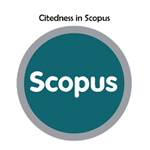Analisis in Silico Potensi Farmakokinetik senyawa Methyl salicylate 2-O-β-D-glucopyranoside dari Ekstrak Daun Sirih Merah (Piper crocatum)
Abstract
Keywords
Full Text:
PDFReferences
R. A. Z. Aziz and E. R. Purnama, "In silico Analysis of the Potential of Red Betel ( Piper crocatum ) Active Compounds as Anti-Inflammatory Drug Candidate Analisis In silico Potensi Senyawa Aktif Sirih Merah ( Piper crocatum ) sebagai Kandidat Obat Anti-inflamasi" vol. 13, pp. 382-392, 2024.
L. E. Septiani, P. K. Atmodjo, and B. B. R. Sidharta, "Kandungan Metabolit dan Aktivitas Antibakteri Minyak Atsiri Daun Sirih Hijau ( Piper betle L .) dan Sirih Merah ( Piper Crocatum ) Terhadap Pseudomonas aeruginosa dan Staphylococcus aureus" vol. 2, no. 1, 2024.
D. Kurnia, S. Lestari, T. Mayanti, M. Gartika, and D. Nurdin, "Anti-Infection of Oral Microorganisms from Herbal Medicine of Piper crocatum Ruiz & Pav" Drug Des. Devel. Ther., vol. 18, pp. 2531-2553, 2024, doi: 10.2147/DDDT.S453375.
F. J. Rachmawaty, D. A. Citra, B. Nirwani, T. Nurmasitoh, and E. Tri Bowo, "Manfaat Sirih Merah (Piper crocatum)sebagai Agen Anti Bakterial terhadap Bakteri Gram Positif dan Bakteri Gram Negatif" J. Kedokt. dan Kesehat. Indones., vol. 1, no. 1, pp. 12-20, 2009, doi: 10.20885/jkki.vol1.iss1.art3.
W. T. Akbar, N.A., Amin, S.,& Wulandari, "Studi In Silico Senyawa yang Terkandung dalam Tanaman Daun Sirih Merah (Piper crocatum RUIZ & PAV) sebagai Kandidat Anti SARS CoV-2" Ejurnal Univ. Bth, vol. 2, pp. 378-391, 2022.
E. R. Noordam, "Analisa Prediksi Farmakokinetik Dan Toksisitas Efek Antikanker Payudara Pada Temulawak ( Curcuma Zanthorrhiza ) Secara In Silico" Indones. J. Pharm. Educ., vol. 3, no. 3, pp. 421-428, 2023, doi: 10.37311/ijpe.v3i3.22203.
A. T. Wicaksono, "Variasi Konsentrasi Senyawa Fitokimia Sirih Merah Dan Pelarut Heksana Menggunakan Gas Chromatography - Mass Spectrometry puncak yang dihasilkan oleh GC-MS ( Madhumita dkk ., 2019 ). Konsentrasi yang digunakan" vol. 3, no. 2, pp. 36-43, 2024, doi: 10.18592/ak.v3i2.11752.
I. Dua and S. Baru, "molekul" 2019, doi: 10.3390/molekul24030489.
E. E. Mgbeahuruike, T. Yrjönen, H. Vuorela, and Y. Holm, "Bioactive compounds from medicinal plants: Focus on Piper species" South African J. Bot., vol. 112, pp. 54-69, 2017, doi: 10.1016/j.sajb.2017.05.007.
A. Wilapangga, U. Aziza, and K. Khotim, "STUDI IN SILICO POTENSI FARMAKOKINETIK TUJUH SENYAWA DARI TUMBUHAN BROTOWALI (Tinospora cordifolia) UNTUK PREDIKSI TOKSISITAS" J. Kesehat. Dan Sci., vol. XIX, no. 2, pp. 858-4616, 2023.
M. R. Gabriell et al., "Studi In Silico Senyawa Aktif Daun Tagalolo (Ficus septica Burm F) sebagai Ligan Uji pada Enzim L-Histidin Decarboxylase" Media Teknol. Has. Perikan., vol. 10, no. 2, pp. 122-126, 2022.
S. Wulan Sari, A. Wilapangga, A. Nawang Sari, S. Astriani Program Studi Sarjana Farmasi Klinik dan Komunitas, S. Tinggi Ilmu Kesehatan Bina Cipta Husada, and K. Purwokerto, "Studi In Silico Potensi Farmakokinetik Dua Senyawa Dari Tanaman Kenaf (Hibiscus cannabinus L.) Untuk Prediksi Toksisitas" J. Bina Cipta Husada, vol. XIX, no. 2, pp. 70-79, 2023, [Online]. Available: http://biosig.ui
D. Rahmawati and A. Wilapangga, "Studi in silico Ekstrak Biji Saga ( Abrus precatorius L .) dalam Mengobati Alopesia Androgenik" vol. 8, no. 1, pp. 32-39, 2024.
A. Pramudiyawati, D. Eka Putri, and A. Wilapangga, "Skrining Studi in Silico Potensi Farmakokinetika dan Toksisitas Senyawa 6,10,14-trimetil-2-pentadekanon dari Ekstrak Daun Ekaliptus" Indones. J. Pharm. Educ., vol. 4, no. 1, pp. 39-46, 2024, doi: 10.37311/ijpe.v4i1.24493.
L. Fu et al., "ADMETlab 3.0: an updated comprehensive online ADMET prediction platform enhanced with broader coverage, improved performance, API functionality and decision support" Nucleic Acids Res., vol. 52, no. W1, pp. W422-W431, 2024, doi: 10.1093/nar/gkae236.
DOI: https://doi.org/10.37311/ijpe.v4i2.26958
Refbacks
- There are currently no refbacks.
Copyright (c) 2024 errol rakhmad noordam

Indonesian Journal of Pharmaceutical Education is licensed under a Creative Commons Attribution-NonCommercial-ShareAlike 4.0 International License.



